
The first intrusion detection system here is the military TRC-3. They can be found at Army surplus stores, gun shows, and online occasionally for $200 to (ouch) almost $1,000. They were made in the late 1960s and still work great today. There is no modern product that is a complete geophone detection package like this very unique device.
Our last visit to the topic of perimeter security took a look at a really nifty tripwire system I found on Ebay. It busts a .22 caliber nailgun blank, and you can hear it for miles on a quiet night in the country. It is extremely low-tech and electricity free, and it works. For this article I am following up with a couple of wireless options, one expensive and one pretty cheap, and both also work really well. Nobody wants to rely on batteries, but any tripwire system is going to have several basic drawbacks:
- The intruder knows he has been detected, and he also knows that someone is trying to detect him. – It is pretty easy to just back out and return with reinforcements, because for sure he just found out that there is something to steal here.
- The trip wire is visible. – My initial tests showed that monofilament fishing line as a trip line was just not the right choice, because it reflects light. One of the commenters on the last article noted that military trip wire is green wire, and that is for sure better, but it still can be seen.
- Once one device has been popped, you have no further information about which way the intruder is traveling. – The dude isn’t going to trip another one now that he knows what to look for.
- Murphy’s Law – If something can happen to your trip line, it will happen. The cap could get wet, which is the worse case scenario because the intruder now knows about you but you don’t know about him.
Detecting an intruder without a trip line can be done one of two ways. The first is obvious. Any home security system these days employs motion detectors, and most of have at least one motion activated light outside. Search Amazon or Ebay for “wireless home security” and you’ll find systems priced at under $100 that will cover your whole house, 100% battery operated. The other method is via a “geophone,” using seismic detection. This is by far the most useful method, because the sensors are easy to hide, and a geophone can detect movement on both sides of a barrier, without having to put a sensor outside the barrier. Compete geophone systems are also rare and expensive.

The probe on the TRC-3 is connected to a transmitter, and you set the sensitivity, with the most sensitive able to detect a man walking 50 yards away.
It is very difficult for me to recommend something that isn’t available and it is with trepidation that I show you the military seismic intrusion detector called the TRC-3 or TRC-3A. Right now there is one guy on Ebay who has the whole set and if you look back through the old ads for it, he thought he was going to get $1,100 for it and now he is down to $800 and accepting offers. But one recently popped on Ebay for $246, and one went in October for the same price. They are around, and if you know what to look for your local Army surplus store may have one sitting there. Gun shows are also a good source for things like these. Mine was bought about ten years ago for $150, on Ebay, and I also bought a similar military unit that was wired, but that was lost in a move.
The TRC-3 uses sealed seismic probes that are each connected to a base radio unit. When it detects a seismic event, it broadcasts a tone. Each transmitter in the 4 unit set has it’s own tone, so you can use the 4 units in overlapping paths to detect direction of travel. On the most sensitive setting the TRC-3 can detect a man walking up to about 50 yards away from the probe, so you can cover some real estate with the four probe units.
Mine didn’t come with the military receiver, and you will find that most out there don’t. Mine came with a little multi-band radio that includes the “air band,” which is used by aircraft to speak to the tower. Most “survival radios” these days don’t include air band, so to replace mine I had to buy one of the radios specifically made for air band, and it is hard to find one under $80. The frequency transmit range of the TRC-3 is 129-136mhz. Mine set broadcasts on 134.5mhz.
The cheaper option, if your set doesn’t come with a receiver, is to buy a Baofeng UV-5R handheld dual band Ham radio for about $35, and get the programming cable for it. Download Chirp software and then you can manually put the receive frequency of the radio below the 136mhz that comes from the factory.
The battery life of the dual 9 volts in the TRC-3 is up to 900 hours, with regular batteries. Modern lithium rechargeables will most likely last twice that. This is plenty of time to rotate two sets through a solar battery charger, which makes this system really realistic. The other thing I find really attractive is that there is no special receiver. You can leave a radio on at home base, and keep one in your pocket on guard duty connected to an ear phone. Any radio tuned to 134.5mhz within about 200 yards picks up the pulses on mine. The manual says it has up to a mile range, but that is probably with nothing in between the transmitter and receiver.

If you search Ebay or Amazon for “air band radio,” you’ll find some hand helds that are under $100, but it’s a lot for a cheap little radio.
The only downside I see to this system (besides cost) is that in an urban setting of any kind it is completely useless. Traffic within a mile will trip the transmit tone, and my neighbor’s well pump tripped it on the lowest sensitivity more than 100 yards away. The manual says that even low flying planes can trip the tone.
If you decide to buy one a TRC-3, make sure you test it first. They are officially waterproof down to 3 meters, but mine has some cracks in the plastic case that are just from age. The circuit itself is fairly simple though, and almost every one that I have seen for sale has included a guarantee that the system works. Also note that the two 9v batteries are wired in parallel, so the transmitters will run on one 9v, but they don’t transmit as far.
Wireless Motion Detection

You can also use this cheap Baofeng Ham radio if you modify the frequencies with software, see article.
I chose the Chamberlain Wireless Motion Alert you see here in the pictures for a number of reasons:
- It’s cheap cheap. – The base unit and one sensor are available on Ebay and Amazon for $50 – $80. Additional sensors are $30 each, up to 7 per base unit.
- This is a very specific system. – There are no zones or window sensors. You can add up to 7 motion detectors to the system, and that’s it.
- The base unit is dual powered and small. – I can run the base unit from the wall wart or put 4 AA batteries into it and carry it in my pocket.
- The base unit can run silent. – There is no earphone jack, but you can turn off the audible tone and just use the LED light.
- No warning to the intruder. – The default on the Chamberlain sensors is a green LED that points forward, toward the threat, but the units themselves are just circuit boards screwed into a plastic inclosure. It is easy to cover the front facing LED with tape or liquid electrical tape.
- It is indoor/outdoor. – Each sensor comes with a hood that clips over it, protecting it from rain and snow.

The other kind of wireless is motion detection. I selected these heavy duty rainproof sensors from Chamberlain.
You also can technically get more than one base unit to use with your sensors. The base unit registers the sensor by pushing a button on each at the same time, so more than one base can be activated by the same sensor. That gives you the same functionality as the TRC-3, but you have to buy the proprietary base units.
If I have a complaint about this type of device is that they are somewhat conspicuous. You have to point them at an open space, and that means you can’t hide them behind something, or in a thicket or something. The best I have been able to do is bury the sensor in a bush, then cut a detection window in front of it. If you aren’t looking for it I suppose it is not obvious, but in a survival situation with active hostiles I wouldn’t bet on them not seeing the sensor before it detects them. If you have more than one sensor, at least you can cross paths with them and get a reading before the sensor is detected. They also don’t have the different tones per sensor luxury feature of the TRC-3. When the alarm sounds there is no way to tell which sensor is being activated.
The Chamberlain instructions claim that the 4 AA batteries in each sensor will last up to two years. The base unit batteries will last about a week. Two sets in a solar charger will do just fine to keep your receiver alive. The sensors are very sensitive, and you get some false positives if there are any close branches that sway in the wind. The receiver works up to a mile away from the sensors, so these are perfect to watch your camp while you are out hunting or scouting. For the money, I don’t think you can beat this very simple system.

The base unit and one sensor can be found for as little as $49. The base unit will accommodate 7 sensors.

My only issue with these is that they blink green in the front when they detect an intruder. No thanks!
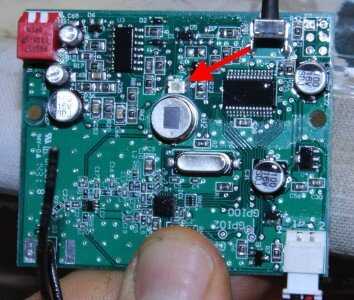
By removing two screws you can get at the board, and dab a bit of liquid electrical tape over that confounded green LED, shown here.
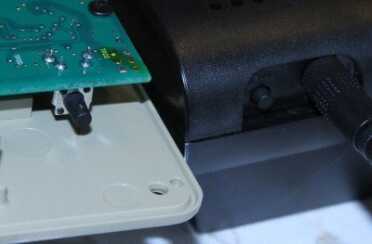
A button on both the transmitter and receiver register the two together. You have to do this before you close up the case after putting in the batteries.

These are the ranges for the various settings, but the unit really needs quiet to operate. This is not the best system for an urban environment.


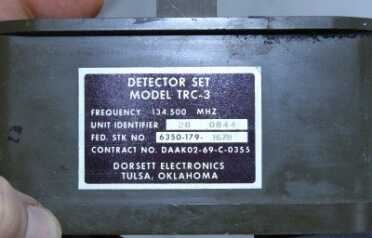


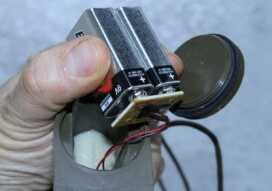
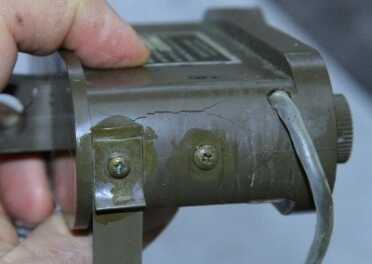


My dog is utilized in an advisory capacity only. I can tell by his bark whether he is excited or not. I’ll take it from there. Night vision is a good investment if you do your research.
The .22 cal Alarms are back up at http://www.alarmmine.com
I have been using the Chamberlain driveway alarm for over 6 years. I got an additional sensor and each of them makes a different number of beeps so you can tell if someone is going by the front or rear of the house. I have been really impressed with mine as far as reliability and battery usage. I don’t have to change the AA batteries for more than a year and I am using rechargeable. I have not had any problems with false alarms but it can happen depending on how you set them up. It’s nice just to get a heads up that someone or something(bear, dog or deer) is around my place. We live out in the boonies up a mountain so if someone is around it is either my closest neighbor going by or someone that is not up to any good. I would highly recommend these units for a cheap solution. Also, my dog has learned what the beeping is and when it goes off he goes to the window and looks out. If it is a person or car he starts barking which clues people in that this is the wrong place to look for trouble.
This is silliness. I have criss-crossing inferred cameras on all 4 sides of my home with motion detection and reporting and a well trained 130lbs German Shepherd that is on constant patrol either inside or outside of my home. The outside part has post and rail fence with chicken wire to keep him in and unwanted out. Cameras are part of home security system that will automatically keep running off 20Kw Generac should the power go down. Should they breach the perimeter and make their way inside, my wife and I have plethora of wonderful welcome gifts in store for them!
I have used the trc-3 ( We called them P-saids ) – Not for home def. In the bush @ night – You want a set –
I make my living doing telephones. I have a customer, an IT computer network guy that has motion detectors and video cameras all around his home, inside and outside. His salary isn’t out of this world, so I know that he doesn’t purchase overly expensive gear, and says that it isn’t. I was working with him one day and he got notification on his iPhone, or whatever type of cellular device he uses, and he looked at it and then showed me…real time live video of the mailman driving up his driveway, then at his door (mailbox). It was actually pretty neat. Again, he has several cameras around both inside and outside his home, and says that as technologies get better and smaller they aren’t/weren’t very expensive. And now I see this article. Gives me ideas. Thanks for the reminder.
For people who want a seismic sensor like the TRC but want a modern relay output or a wireless transmitter we sell a modern version with battery that can last up to a year but the detection zone is up 40ft for humans to keep the system reliable.
The TRC systems in a modern world would produce lots of false alarms unless installed in an isolated area, our system was designed to be places are soft spots, choke points and open areas like back or front yards to detect intruders and to be connect to your standard alarm system.
http://www.rbtec.com/sites/rbtec/UserContent/files/SIESMO%20-%20Buried%20Seismic%20Sensor.pdf
Hi Dori,
Where can I find these to purchase?
Thanks
Hi Russ,
You can look on our website rbtec.com
or call 301-760-4016
The option for the Baofeng Ham radio for use within the air band is not correct. Air band is AM and the Baofeng UV-5R is and FM only radio.
Correction on the Skylink alarm. It can handle up to 16 sensors, motion or magnetic. There are just 4 zones and you group sensors into those 4 zones. The motion detectors are outside rated. I’ve used mine for over a year in brutal Iowa weather. Only problem was condensation in one that caused false alarms. Laundry blowing on a clothes line will set it off. You can adjust detection area by taping over part of the lense with electrical tape. The system is called 2 in 1 Alarm / Alert. Website is here: http://www.skylinkhome.com/usa/household_overview.html
Thanks
Living rurally, and on a cul-de-sac street, the Chamberlain system works very well. We installed one sensor pointed to the street and one sensor deeper into the driveway. When a car goes by on the street, three beeps announce it. If something comes into the driveway, six beeps announce it. There is enough information provided to justify a trip to the window. Add security cameras and you can have an effective system for less than $500.00 if you do it yourself. The Chamberlain sensors have proven to be very reliable for the past five years.
Have you ever thought of using hunting Trail-Cams? The LED can be switched OFF, usually cammo colored, some have a transmitter module or a add-on TX can be purchased and most have external battery/solar.
The biggest issue in your story is the base unit needs a DETECTION ALERT, as few will be watching the base unit 24/7. All base units need an external DETECT latch switch – allowing a horn, strobe, etc. One key item is you want any battery mode unit to do is consume millivolts of battery power or go into sleeping mode where it detects for 1sec every 30seconds to conserve the battery or the unit needs an external power/charging connection (for a remote solar cell up in a tree for self charging only using the batteries during no-sun)…. Making rounds to the sensors more than once a week can create a detectable ground path during various times of the year. Much less the cost and charging of an extra set of batteries.
Making a Z-axis geophone sensor is not all that hard – sending the signal to <3mW FM TX other than it will eat batteries…. And the base unit will require a specific RX with an audio PLL-circuit for the activity detector.
My poor-mans geophone uses a cow-belly magnet, a very light spring, PVC, and 30AWG Magnet wire; the sensor is in the Vertical Z-Axis, with one spring on either end of the magnet as the magnet moves within inducing a voltage into the multi-turn coil around the PVC that is centered over the magnet at rest. Sensitivity is proportional to the spring K factor – so the lighter the better, I stretched my spring and cut off some turns to get it to be very very sensitive. Use the voltage to control a simple 555 audio chip into any TX mic input. There is more to the circuit but that is the gist of it. Such as a voltage detector that triggers the TX PTT on/off (minimizing battery consumption). The range is interesting as I sure can hear earthquakes many states away, or I can tell you if the train a 1/2mi away is loaded or empty, or when the trash truck goes by on the street, detecting foot steps all depends on how/what they walking on. Cement/rocks best distance, soft ground with leaves very short distance maybe 15'.
I think the TRC3 you write about was used in Vietnam to detect the VC on the Ho-Chi-Mihn trail, they would carpet bomb that section of the trail – but the sensor also got blown up, so special-forces/SEALs would sneak back in to replant new TRC3's that was usually within 10' of the trail, hence why Aircraft bands were used so the FAC's could listen and call in strikes. Now days it would go to a SAT.
I actually rigged up a couple that work wonders using some Monofilament fishing line, a rat trap, a 2×4 and a 12 gauge shotgun shell.
If a person hits that trip wire, they hear the shell go off and assume that they are being shot at and deass my property….especially if they see where it’s hitting the ground instead of pressing on further, plus ill hear it anywhere on my 398 acres of land.
This would qualify as a federal crime. You can’t set up anything on a trip wire that is lethal.
If all breaks down what would be a federal crime?
A potentially deadly booby trap. It is of course also a state crime in probably all the states as well.
“My initial tests showed that nonalignment fishing line” What the hell is nonalignment fishing line ? You mean monofilament fishing line ?? And the Chamberlain works just fine.
I’m with the “get a dog” crew – as long as the dog is well-trained. Agree with the most aren’t trained crew about that.
None of these devices work very well when you have an abundance of game and a large perimeter; even the military issue. Metal detection might be an option; any human threat would carry a detectable-level of metal. But do such devices exist in a way that a consumer can get their hands on them?
The solar charged battery light systems work well, has anyone come out with one of those for powering the perimeter sensors?
There are video cameras that work on 12 volts and you can wire these sensors on a 6v system. There are some geophones that can be made into remove sensors and I hope to develop a DIY circuit for a future installment.
Check out the battery powered driveway alert system from Harbour Freight Tools. Reliable, sensitive, and the intruders don’t know they’ve been noticed. Multiple frequencies allows you to set up a perimeter also. $13.99 each.
I use a Chamberlain as a driveway alarm. Works great, if I’m taking a nap the FedEx guy doesn’t sneak up on me. The blinky light is noticeable. The first time my son visited he ask me what the light in the bushes was. As for the old dog, he is asleep on his bed like me.
My wife works at an old folks home .And She brought a thing home by accident one day .I found out to be a presure sensor it is used to know when the elderly get out of bed or chair .I was checking it out and thought of many use’s.attached to the pressure pad in a small plastic box this holds a 9 volt .And also a high pitch scream that dose not stop until reset.It works two ways .either there is some weight on it and once it moves it goes off .This is how the nursing home used them..You could use this to catch some one stilling anything supply’s etc.The other way is to set it once pressure goes on it and them is removed it will alarm.I have never thought until now.About looking for them it slipped my mind .Although I believe that they would be cheap i am just guessing but most likely around 10 to 20 dollars.I cant remember the name on it but am going to look in to it.Have a blessed day. Timothy Thomas Florida.if any one want to check for them .I would type in a search elderly body alarm .Or also under elderly fall prevention products.
wireless perimeter alert?
Dude.
Get a dog.
Read the article but maybe I missed the part of the Chamberlain detector , you put liquid tape over the LED light on the Chamberlain or on your TRC? I sure its on the Chamberlain because I haven’t ever seen a LED on the TRC. Have you tested the ( C ) unit for distance, I know trees hills interfere with distance, I have or would like to go around 800′ straight line, no trees or hills, all open space, the other is long drive with some trees.
Stony
Get a dog? Pet ownership should be outlawed. Since 95% of people don’t train their bloody dogs, dogs are more of a nuisance than a burglar, most often. Then you have to feed dogs daily, clean up their poop daily, and then still have to live with an unclean, pee-smelling yard. Or, if the perp is smart, a tainted hot dog or steak will take down the dog without a sound. Yeah, great idea. Wireless it is, Nate! Perhaps a better idea is to put in a wireless system and install invisible dog fence stakes so perps will -think- you have a dog. No noise, no feeding, no mess, no stink, + added protection. Win/win.
Humans have been living with dogs for about 10,000 years, and for good reason. A well trained dog will not eat random food drops, and with their ability to track, and if trained properly defend, you would be an idiot to exclude one from your system if you were interested in the concept. Or like me, include 4. All are police dog trained, and though you are correct that 95% – or more – do not train their dogs, and they would have to be watched far more closely. The “pet ownership should be outlawed” comment is just a troll or outright ignorance, and after reading your comment I am still not sure which it is. All successful military units in recorded history had & used dogs, and in many regards I would take one of my dogs over a “survival buddy” human every time. But more to your point – I do not use them as perimeter detection running loose willy-nilly, but they come with me & my wife when patrolling the property. We each take one, and 2 stay inside the fenced-in exclusion zone at the house. They keep quite and will not act unless ordered to do so, unless we are being immediately threatened. The TRC-3’s & 3a’s are great, and every now & then you will find them at a good price. I find a good one every few years, and now have 4. I have an actual military receiver, and some air-band radios. I can tell you the military receiver picks up the tones at 3x – 4x the distance of a commercial air radio. Must be the sensitivity is greater, or perhaps nearband rejection plays a roll. In any case good article. One weakness – I live in a rural area on a 300 acre property teaming with wildlife (deer, bear, coyote, fox, bob cat, and all the usual smaller animals). Most of them will set the TRC-3 off, especially deer and bear. Keep this in mind if you live in a rural area – there will be a lot of false positives. And in urban areas, these are basically useless for perimeter work. Tried to see if it would work in a buddy’s house in Baltimore – besides folks just walking down the sidewalk setting it off, so did trains, busses, and cars with bass booming speakers. So keep in mind your situation and what you reasonable expect in perimeter detection before putting down hard earned cash.
I use Skyline alarm system. It takes uptown 4 motion detectors separate led for each. Audio can be siren or beeps. Beeps are 1-4 busts.so you know which sensor tripped. Also alerts you if a sensor goes silent due to dead battery or vandalism. Very sensitive.
You’re right these are not perimeter defense or alerts in any shape of the word. They would be helpful if they had a dry contact closure function as the alarm tone is so brief it is easy to miss and would never wake you up. Range of detection is fair. I have a 20′ wide driveway and had to put one on each side to make it foolproof. Xmission range does not seem to be a problem. I found it easy to add sensors to one reciever. Pricing is dumb. Cheaper most places to buy 2 main units than one main unit and a separate sensor. Which is what I did and set the one recvr aside. Small branches do set them off when the wind blows but the tone is very short and easy to ignore from when a real alert comes in.